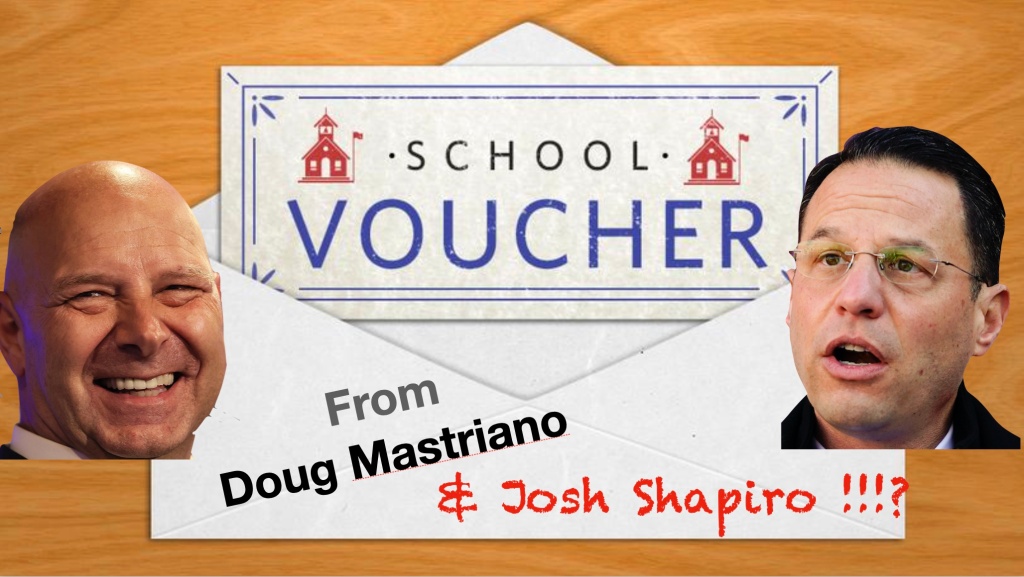
Dear Josh Shapiro,
Are you for public education or not?
I only ask because as the Democratic candidate for Governor in Pennsylvania, you come off as the savior of schools and children on the campaign trail.
You say you want to increase state funding to public schools. Wonderful!
You say you want to reduce standardized testing. Excellent!
You want to guarantee every student has access to technical and vocational courses and make sure every school building has at least one dedicated mental health counselor on staff. Outstanding!
But in interviews and on your campaign Website, you say you’re in favor of school vouchers!
Wha-Wha-What!?
Did Charles Koch just hack your election headquarters? Is Betsy DeVos impersonating you in the media?
Because supporting school vouchers does not fit in at all with someone who claims to champion public education.
Public education means public schools. It means tax dollars being used to fund public schools and those schools being run by elected school boards.
It does not mean tax dollars going to private and parochial schools. It does not mean our money going to institutions where we get no say in how it’s spent. It does not mean circumventing duly elected school boards. It does not mean the public paying for religious indoctrination or the kind of right wing biased education routinely provided at private schools.
But that’s what school vouchers do.
They steal taxpayer dollars from authentic public schools and allow them to be wasted on private and parochial schools. They destroy any accountability for how our collective money is spent and do serious harm to thousands of the most struggling authentic public school students while lining the pockets of private companies and religious institutions.
And the separation of church and state – forget about it!
This doesn’t sound like the candidate teachers like me have been backing since before this election cycle began. Frankly, it’s almost what your gubernatorial opponent, MAGA Republican Doug Mastriano, champions.
Mastriano – a Trump insurrectionist – says he wants to use state education funding to give EVERY student a school voucher they can use at almost any school in the Commonwealth – public, private or parochial.
You seem to want vouchers ONLY for students at the most underfunded and struggling schools.
Well that’s some distinction!
Instead of providing more support to the most inequitably funded schools, you want to slash their funding even more in the name of some old time Republican plan to let a few escape a bad situation while the rest all drown!?
That is repulsive!
On your your campaign Website it says:
Josh favors adding choices for parents and educational opportunity for students and funding lifeline scholarships like those approved in other states and introduced in Pennsylvania.
In an interview in the Patriot News you say:
“And I’m for making sure we add scholarships like lifeline scholarships to make sure that that’s additive to their education. That it gives them other opportunities…to be able to help them achieve success”
These so-called Lifeline Scholarships are a Republican lead measure to give direct-to-student tax-funded scholarships that parents and guardians in the state’s most neglected public schools could use for a variety of options including going toward tuition at a different school.
The GOP sponsored bill passed the state House of Representatives in April on a 104-98 vote and cleared the state Senate Education Committee in June. However, because of an amendment to protect low performing charter schools from losing their funding, it would still need final passage votes in both chambers before getting to current Gov. Tom Wolf’s desk where he would almost certainly veto it.
It would affect about 191,000 students in 382 schools, across 76 of the state’s 500 school districts. However, Two-thirds of the cost of the program (63.1%) is born by four districts – Philadelphia (43.9%), Reading (8.9%), Allentown (5.8%) and Pittsburgh (4.5%).
This would create another taxpayer funded system of education. Affected districts would lose so much funding it would ultimately force them to reduce programs, services, and staffing and/or raise property taxes to compensate.
Moreover, these would be the most neglected districts, and thus the least able to support the cost.
It’s a terrible idea, and I can’t understand why you would buck the overwhelming majority of your party and would-be constituents to support it.
Is it because you send your own kids to a faith-based private school, and that you are the product of just such an education, yourself?
This is how you lose votes, Sir.
Your opponent is perhaps the most odious person to ever run for Governor in the state. He looks to usher in an era of theocratic fascism, curtail human rights and take the Commonwealth back to the Middle Ages.
But that doesn’t mean you should run closer to his positions in the vain hope of stealing some of his base.
The MAGA Republicans will never vote for you. Dressing yourself up in their clothing will not help you do anything but disgust your own supporters until some can’t bring themselves to vote at all.
As election day nears, the polls get closer and closer between Mastriano and you.
Pennsylvanians can’t afford losing their only chance at self rule because of demoralization and despair at a candidate too weak to support the platform he began this campaign on – championing public education.
I urge you to reconsider this flirtation with Republican values and school vouchers.
I hope you are better than this.
We deserve a governor who is better than this.
Please have the courage to stand by authentic public schools.
Yours,
Steven Singer
Tell Josh Shapiro what you think. Email him here: contact@joshshapiro.org
Like this post? You might want to consider becoming a Patreon subscriber. This helps me continue to keep the blog going and get on with this difficult and challenging work.
Plus you get subscriber only extras!
Just CLICK HERE.

I’ve also written a book, “Gadfly on the Wall: A Public School Teacher Speaks Out on Racism and Reform,” now available from Garn Press. Ten percent of the proceeds go to the Badass Teachers Association. Check it out!






